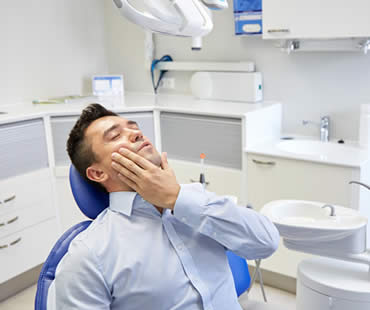
An aching tooth can make your life miserable. Pain, difficulty eating, inability to sleep, headaches and earaches are some of the problems that often accompany a toothache. If you have any of these symptoms and suspect a damaged tooth, a trip to the dentist is in order to see if root canal treatment might be needed.
What is root canal therapy? Although it has gotten a bad reputation over the years, it is the best way to save your tooth once infection has set in. The cause for the problem can vary, including deep tooth decay, a faulty crown, trauma, or repeated dental procedures. Once the inside of the tooth called the pulp becomes damaged, root canal treatment is the ideal solution. If you don’t seek treatment, severe pain and possible tooth loss may be in your future.
During root canal therapy, the damaged tooth pulp is carefully removed so that the interior of the tooth can be thoroughly cleaned and disinfected. Then the tooth is filled and sealed using a special material. Finally, the tooth is fully restored with a crown or filling to offer protection from future damage.
What are the positive outcomes of root canal treatment? First, it gives you back the complete function and natural appearance of your real tooth. You avoid getting a hole in your smile or needing a procedure like a dental implant. Root canal treatment restores your normal sensation and biting force, providing for efficient and painless chewing. This treatment also protects other teeth from receiving excessive wear, since your real tooth remains in place and able to take its fair share of tooth wear. Of course, treatment will also relieve the pain and other symptoms associated with your damaged tooth.
Root canal treatment is usually quite simple when performed by a qualified dental professional. Modern techniques allow the process to be as comfortable as just getting a normal filling. The procedure may be completed in only a couple of appointments and the end result will be a long-lasting, healthy tooth.
We treat patients from Sicklerville and the surrounding area

Dental implants are used to replace individual or missing teeth or to anchor loose dentures. For many patients with these issues, traditional dental implants may not a viable option. For example, a patient who does not possess adequate bone levels to anchor the implants would not be a good candidate for traditional dental implants. With mini dental implants, the bone required to anchor the implant successfully is much less.
Thanks to advances in implant dentistry, these patients have other options. Mini dental implants have emerged as an attractive choice for cases that are not conducive to the placement of traditional implants. For the patient who has inadequate bone, the bone required to successfully anchor mini dental implants is much less. Unlike traditional implants, the placement procedure for mini dental implants is a minimally invasive procedure that can be completed in one appointment by a specially trained general or family dentist. Because the procedure is less involved, the pain and length of recovery is greatly diminished.
Patients who have existing health conditions that would preclude them from more invasive surgery may find mini dental implants an extremely appealing option. Mini implants are also a perfect choice for restoring one missing or damaged tooth. Should implant failure occur, grafting procedures would not be necessary because of the small size with mini dental implants.
Most importantly, mini dental implants maintain the look, feel and function of your natural teeth. While you have to wait months for traditional implants to fuse with the bone, mini dental implants are ready for immediate use. Talk to your dentist to determine if mini dental implants would be a good option for your dental restorations and get ready to face the world with a confident new smile.
If you need a dentist in Sicklerville contact us today

Many children aren’t excited about seeing the dentist, either as a result of comments others have made or the idea of an unknown experience. Dental visits are necessary for everyone though, beginning around the child’s first birthday. Here are some basics to know about your child’s dental care.
What happens at the first appointment?:
When your child sees the dentist for the first time, the dentist will look for tooth decay and determine your child’s risk for it. You will be shown how to properly clean your child’s teeth. Also, your dentist will explain the risks of habits that may affect your child’s teeth, such as thumb sucking or sugary drinks.
How often should my child see the dentist?:
You should continue to take your child to visit the dentist every six months, or in some cases more often if your child’s risks are high for tooth decay. Regular checkups can reduce your child’s risk for cavities because plaque will be removed and fluoride will be applied to strengthen the teeth. Also, potential dental issues may be caught early to avoid problems in the future.
What if further treatment is recommended?:
Even though your child might not have permanent teeth yet, dental work may be required on baby teeth too. Cavities can be painful and should be filled. Also, healthy baby teeth help your child properly chew, speak, and develop permanent teeth.
How can I help my child feel more comfortable?:
It is important to help your child’s dentist visits go smoothly so that lifelong habits of regular checkups without fear can be developed. You might consider choosing a pediatric dentist who specializes in children’s oral health and is trained to help kids through the dental visit. Discuss an upcoming dentist appointment with your child, and explain what to expect during the visit. If possible, take your child by the dentist’s office before your first appointment to see what it’s like. During the checkup, remain near your child to increase feelings of security and comfort.
If you live in the Sicklerville area contact us today

While not everyone needs to have their wisdom teeth removed, third molars are the most likely to cause you serious dental problems. Monitoring the health of your wisdom teeth, with cooperation from your dental professional, is the best way to avoid serious complications before they arise. The following are indications you may need to consider oral surgery to extract trouble wisdom teeth:
- Wisdom tooth pain could be a result of infection and decay. Third molars are the most difficult to clean, due to their position at the back of the mouth, making them a prime breeding ground for plaque and bacteria which then attacks the tooth.
- If you have a small mouth, the emergence of wisdom teeth can cause crowding of existing teeth. As wisdom teeth appear they may begin to force your other teeth out of the way, causing misalignment. Removing the third molars makes room for existing teeth.
- Wisdom teeth that do not emerge properly can cause irritation to the gums that may lead to gum infections and immense discomfort.
- When wisdom teeth start to emerge at awkward angles, it can cause them to become impacted. Third molars that get stuck in the gums sometimes create pockets that harbor bacteria and debris that cause serious decay and infection, as well as bad breath issues.
While not all wisdom teeth require extraction, there are many complications associated with third molars that indicate removing them would be in your best interest. By monitoring the emergence and ongoing health of your wisdom teeth, you can avoid serious dental problems. Consult with your dentist about the condition of your wisdom teeth to ensure a lifetime of healthy teeth.
Schedule your appointment at our Sicklerville dental office

A brighter smile can make a big difference in your appearance. There are lots of choices today for improving your tooth color. Here are details about some of the options so you can decide which way you may want to whiten your smile.
Eliminating the need:
One way to eliminate the need for teeth whitening is to avoid foods and drinks that are known to cause stains. These include items like coffee, tea, red wine, berries, soy sauce, balsamic vinegar, and curry. If you do consume foods that stain, try to brush your teeth as soon as possible before stains can attach to your teeth.
Whitening at home:
There are many products available at your drugstore to help you brighten your smile at home. Whitening toothpastes and mouthwashes are two types of options, although it can take a while to see results from these methods. Whitening strips are a popular choice, which are covered in a bleaching solution and attached to the fronts of your teeth. Depending on the brand and strength, they might be in place from 5 to 30 minutes daily for a week or two in order to achieve the desired results. Overuse of these strips can increase teeth sensitivity, so be careful not to use them too often.
Professional whitening:
Whitening procedures performed at your dentist’s office are usually the fastest and most effective way to spruce up your smile. Custom trays filled with a higher strength bleaching gel may be made to be worn either in the office or at home later. Another method that must be administered in the office involves a bleaching agent applied to your teeth’s surface and then a bright light to speed up the process. You can typically expect dramatic results from this type of professional whitening.
Our dental office is located in Sicklerville

Whitening your teeth to improve your smile is a popular cosmetic treatment, but you should understand that it does have some limitations to consider. If products are used correctly or if you seek the professional help from a qualified dentist, you can usually achieve a bright and appealing smile. Here are some things to think about when it comes to teeth whitening.
Methods:
You should not expect over-the-counter methods to whiten your teeth more than a couple of shades. The whitening ingredients available in products at your drugstore are not as strong as those used at your dentist’s office. Consistent and correct use of over-the-counter options can help whiten your teeth, but it may not be as much as some patients hope will occur. On the other hand, professional methods can produce dramatic and quick improvements to the color of your teeth.
Habits:
Certain habits contribute to stains on your teeth and if you don’t limit or stop activities prone to discoloring teeth, your newly whitened teeth may become discolored again. Foods like berries and curry, drinks such as coffee and red wine, and habits like smoking will all likely negatively affect your tooth color.
Restorations:
Bridges, crowns, and laminates might not respond in the same way to whitening agents as your natural teeth do. Ask your dentist about how your restorations might react to teeth whitening.
Side effects:
Tooth sensitivity is the most common side effect of whitening procedures, causing some patients to be unable to handle some methods of treatment. Gum sensitivity is another potential problem, but usually dissipates soon after the whitening procedure. Weakening of a restoration may also occur during whitening treatment, sometimes making it necessary to replace them.
Expectations:
Teeth whitening must be occasionally repeated if you want your bright smile to remain for a lifetime. The effects do not last indefinitely, because aging and activities can stain your teeth. Excessive bleaching may damage your teeth though, so be sure to discuss your whitening treatment with your dentist.
We treat patients from Sicklerville and the surrounding area












